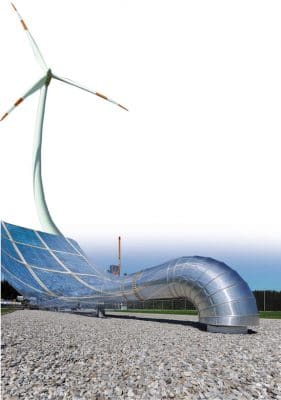For years, renewables and fuel cells powered by fossil energy sources have been worlds apart, something that is changing – at least when it comes to natural gas. Many companies have realized that there are indeed areas in which both industries could benefit from collaboration. Several large associations have already started to emphasize commonalities instead of differences, especially regarding energy storage.
Years ago, the German Technical and Scientific Association for Gas and Water gradually took to the idea of incorporating hydrogen and power-to-gas into their energy strategy (see the January 2011, April 2012 and January 2014 issues of German-language magazine HZwei). Meanwhile, the Zukunft Erdgas advocacy group has begun to express opinions that go in the same direction. The theme running through the news conference it organized in late June was that the coal industry was now the “bad guy” and natural gas could be the “yin to the renewable energy’s yang.” Timm Kehler, managing director of Zukunft Erdgas, said: “Our objective is to help a bit with dispelling the oft-heard notion in politics that fossil and renewable energy carriers don’t go together.”
The lobbying organization sees the role of natural gas expanding from energy production to storage. Kehler said that “renewables need reliable partners to balance their natural volatility.” He added: “It takes relatively little time to start up and switch off natural gas plants. They can be relied on to balance fluctuations in renewable power output even at short notice and emit half as much CO2 than brown coal power stations. And at 60 percent, they have an extremely high efficiency.”
The association drew special attention to the gas grid’s storage opportunities for renewable energies (total length: 500,000 kilometers or 310,686 miles) thanks to power-to-gas. It made natural gas “the best supporting option for transforming the energy market,” as renewable power could not only be fed into the grid and stored there – even seasonally – but also be delivered through the network.
Power-to-gas case study
At an event in Berlin, Zukunft Erdgas presented a new study that said, fittingly, power-to-gas had “great potential for bringing about a successful transformation of the energy sector.” For this Delphi survey, the association had nymoen strategieberatung send questionnaires to around 30 power-to-gas plant operators. Nine of them participated.
The industry professionals expect power-to-gas technology to make “significant inroads regarding efficiency over the next 10 years and lead to a 50 percent or higher reduction in costs by 2030.”
…
When the study was presented, Kehler also announced the simultaneous start of a marketing campaign called “Greener than you think.” And hastened to add: “The fuel cell is extremely important to further innovations.”
“Our energy market transformation is facing storage difficulties and power-to-gas is key to the largest energy storage in Germany. […] Power-to-gas is a technology we see as the battery of a future energy market.”
Timm Kehler, board member at Zukunft Erdgas
“We believe that transforming the energy sector by only relying on electricity is the wrong avenue to pursue, economically. It will merely lower acceptance. We regret that there are those such as state secretary [Rainer] Baake who very clearly want to take us down this path.”
Constantin H. Alsheimer, CEO of Mainova
“We need to harvest the energy provided by stormy and sunny weather alike, so that we won’t be freezing in winter. The only way forward is power-to-gas.” [He drew parallels between future energy supply and agriculture, saying that corn basically consists of solar energy and is harvested and stored in summer to get one through the winter.]
Stephan Bauer, manager of the Underground Sun Storage at RAG Austria
The regulatory agency’s dogma
During the concluding roundtable, Constantin H. Alsheimer repeated a question he had recently asked Jochen Homann, president of the Federal Network Agency: “Why isn’t there any request for bids to set up a pilot power-to-gas plant, at least in northern Germany, to convert wind energy into gas and transport it through the grid to the south? This kind of project would make it apparent relatively quickly where the biggest chunk of the cost goes and whether the system could be scalable. Why isn’t there even an attempt to implement this?”
Homann had replied that the he didn’t want to divert political attention from the Ultranets, meaning the planned high-voltage lines. And Alsheimer said to him: “That’s a dogma costing us a lot of money. It’s not a technology-neutral approach, not good for competition and a very regrettable development.”
…



























0 Comments